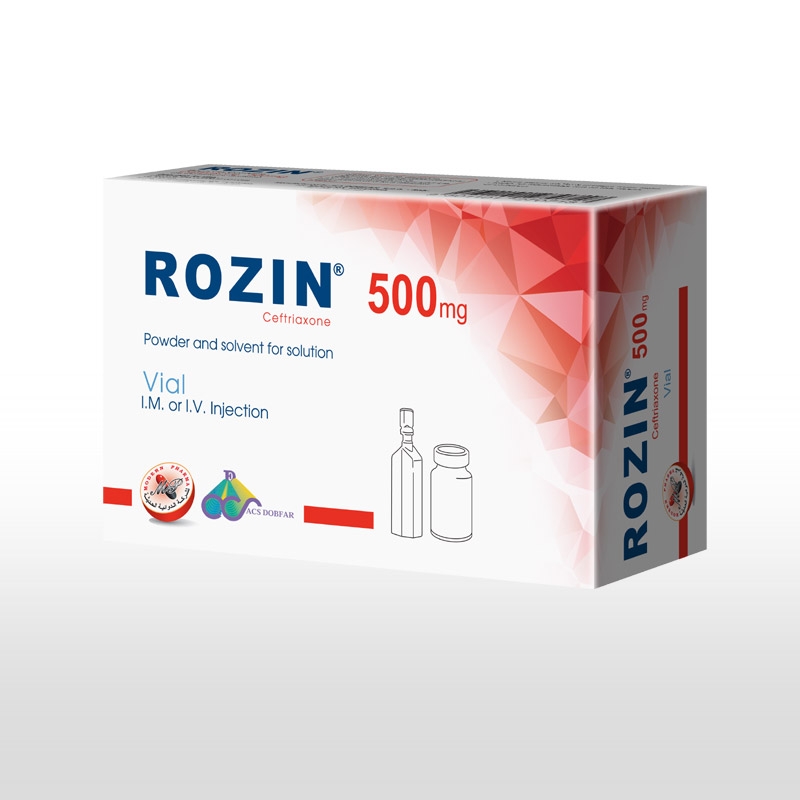Rozin 500
- Ceftriaxone is a sterile, semisynthetic, long acting, broad spectrum antibiotic
belong to third generation cephalosporins.
- Ceftriaxone inhibits bacterial cell wall synthesis following attachment to
penicillin binding proteins. This results in the interruption of cell wall
(peptidoglycan) biosynthesis, which leads to bacterial cell lysis and death.
- Ceftriaxone exerts in vitro activity against a wide range of Gram-negative and
Gram-positive micro-organisms.
- Ceftriaxone is usually active in-vitro and in clinical infections against the
following:
Gram-positive aerobes: Staphylococcus aureus, Staphylococcus epidermi-
dis, Streptococcus pneumoniae, Streptococcus pyogenes, Streptococcus
agalactiae, Streptococcus viridans, Streptococcus bovis.
Gram-negative aerobes: Aeromonas spp., Alcaligenes spp., Branhamella
catarrhalis, citrobacter spp., Enterobacter spp. (some strains are resistant), Escherichia coli, Haemophilus ducreyi, Haemophilus influenzae,
Haemophilus parainfluenzae, Klebsiella spp., Moraxella spp., Morganella
morganii, Neisseria gonorrhoeae, Neisseria meningitidis, Plesiomonas
shigelloides, Proteus mirabilis, Proteus vulgaris, Providencia spp., Pseud-
omonas aeruginosa (some strains are resistant), Salmonella spp., serratia
spp., Shigella spp., Vibrio spp., Yersinia spp.
Anaerobic organisms: Bacteroides spp.,Clostridium spp. (except Cl. diffi-
cile ), Fusobacterium spp. (except F. mortiferum and F. varium ),Peptococ-
cus spp., Peptostreptococcus spp.
Note: Many strains of ß-lactamase-producing Bacteroides spp. (notably B.
fragilis) are resistant.
- Ceftriaxone is highly stable to most ß-lactamases, both penicillinases and
cephalosporinases, of Gram-positive and Gram-negative bacteria.
- The area under the plasma concentration time curves after l.V. and l.M.
administration of Ceftriaxone is identical. This means that the bioavailability
of ceftriaxone administered l.M, is 100%. On intravenous administration,
ceftriaxone diffuses rapidly into the interstitial fluid, where bactericidal
concentrations against susceptible organisms are maintained for 24 hours.
-Ceftriaxone is reversibly bound to albumin, and the binding decreases with
the increase in the concentration. The average extent of diffusion in the
cerebrospinal fluid in bacterial meningitis is 17% of the plasma concentration.
- In patients with renal impairment or hepatic dysfunction, the pharmacokinet-
ics of ceftriaxone are only slightly increased. If kidney function alone is
impaired, biliary elimination of ceftriaxone is increased; if liver function alone
is impaired, renal elimination is increased.
- Ceftriaxone is characterized by an unusually long elimination half-life of
approximately eight hours in healthy adults. In infants aged less than eight
days and in persons over 75 years of age, the average elimination half-life is
about twice as long.
- In adults, 50 - 60% of ceftriaxone is excreted unchanged by the kidneys, while
40 - 50% is excreted unchanged in the bile. In neonates, renal elimination
accounts for about 70% of the dose.


